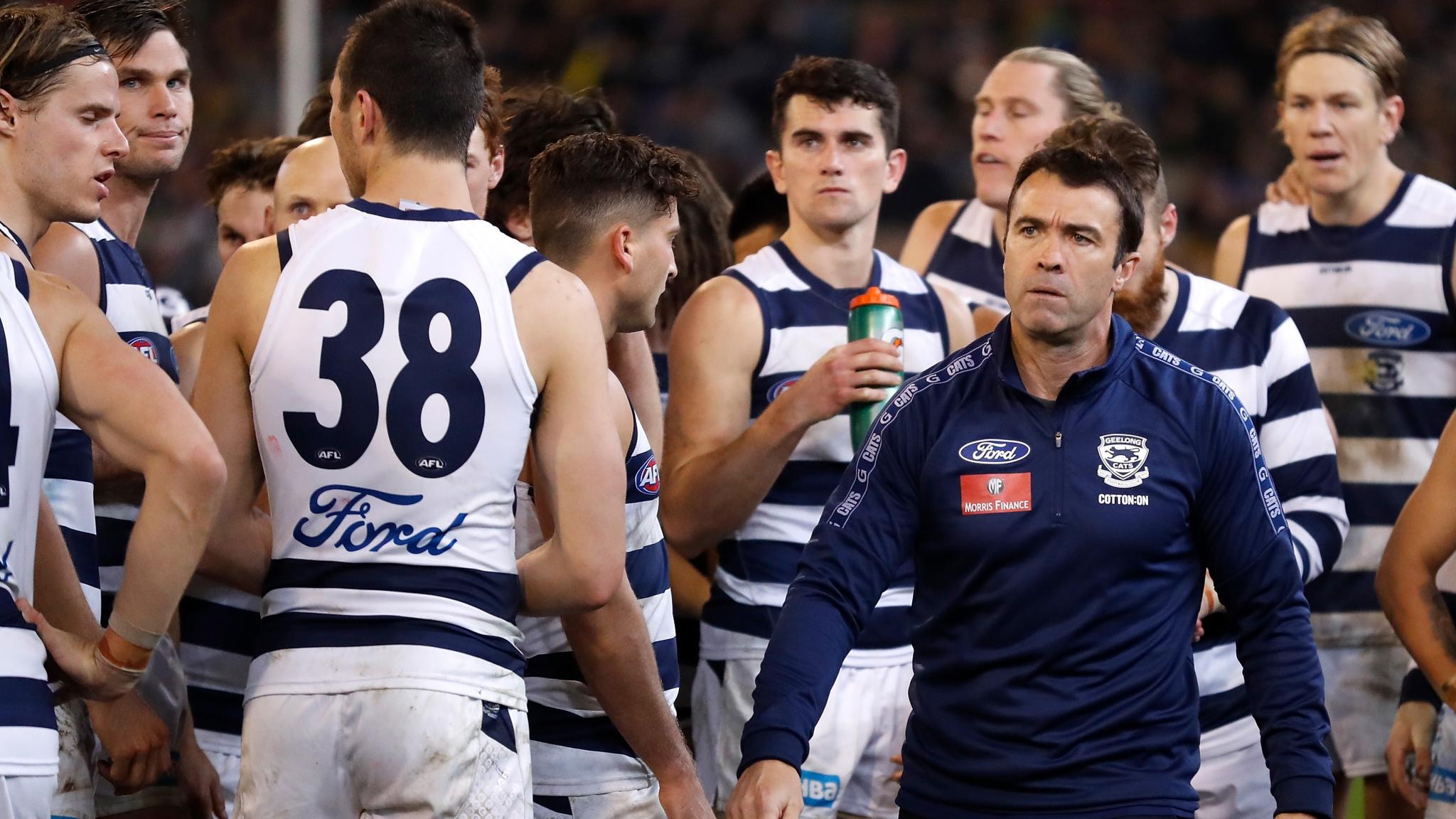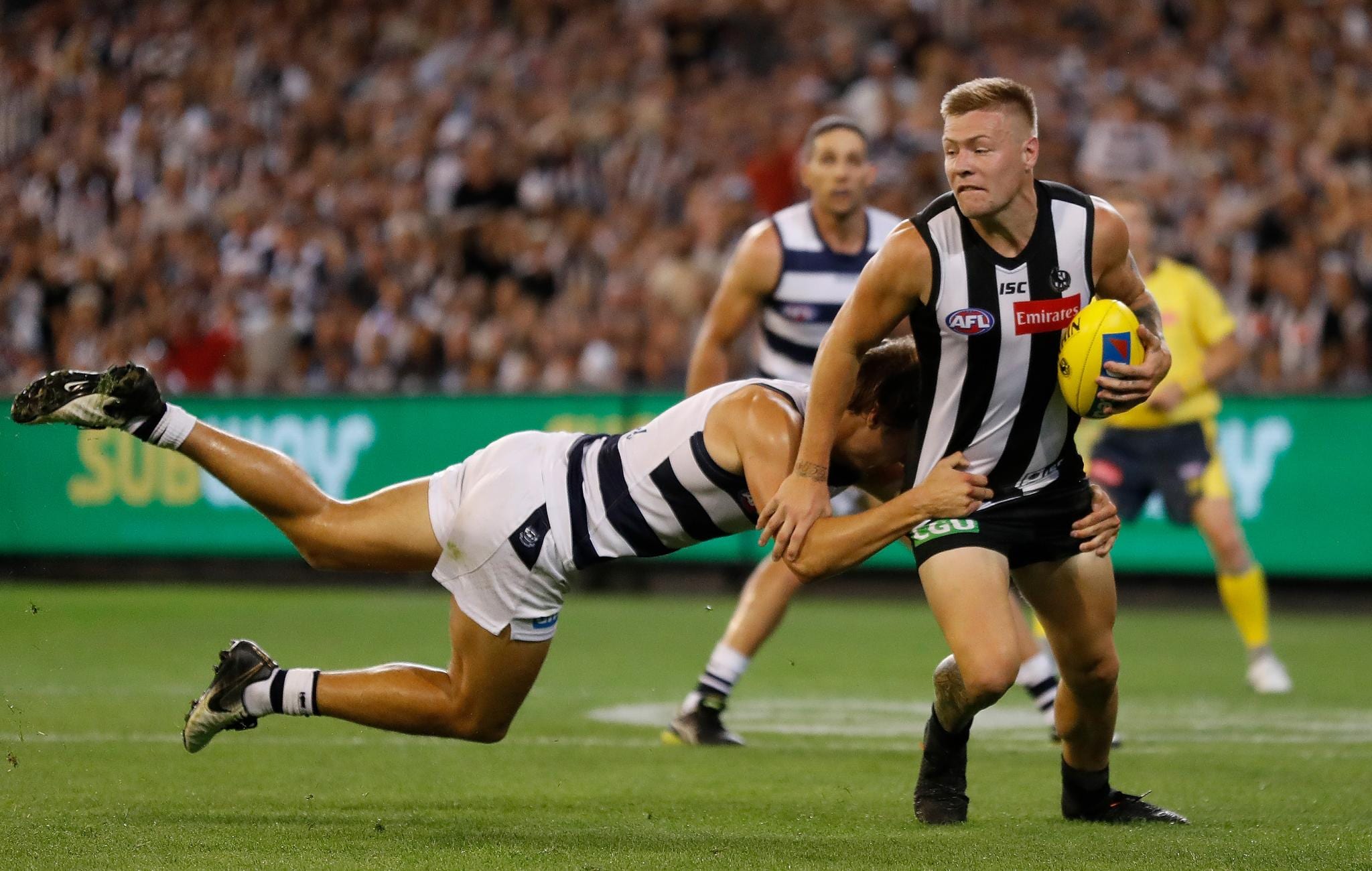TWO DAYS out from round one, Chris Scott was preparing for the worst.
Set to mix a new gameplan with the toughest opening six weeks of any club in the AFL, the Geelong coach summoned his assistants to an off-site meeting.
Joined by head of football Simon Lloyd, Scott demanded his coaching staff be united and stay the course with the impending changes, should the Cats' situation turn ugly.
Chris Scott has got everyone on board at Geelong in 2019. Picture: AFL Photos
After a pre-season pushing a different direction, Scott reiterated the way the Cats wanted to play, but also conditioned his colleagues to the potential of it all unraveling to a 0-5 or 0-6 record.
A date with a hungry Grand Final runner-up Collingwood awaited in round one, with Scott committed to debuting four fresh faces under the bright Friday night lights at the MCG.
Melbourne, Adelaide, GWS, Hawthorn and West Coast were to follow – meaning the Cats would face five of the top six 2018 teams before April was over.
"Scotty got us coaches together and said 'Look, we've got a really tough draw, there's every chance in five weeks we could be sitting there at 0-5'," assistant Nigel Lappin told AFL Nation.
THINGS WE LEARNED Time to make some big calls, Clarko
"(The message was) we just want to make sure we're galvanised as a group and we understand what we're striving towards and what we're building towards.
"No matter what happens, let's stick together."
Twelve weeks on and the Cats return from their mid-season bye at 11-1 ahead of a trip to face Port Adelaide.
CAN CATS KEEP PURRING? Full preview of Port Adelaide v Geelong
Those recalling Scott's March 20 meeting this week believe it was as important as any held over summer following the humiliating elimination final exit at the hands of Melbourne.
Led by chief executive Brian Cook, the Cats' senior hierarchy had completed a "health check" post-season in order to make amends in 2019.
Find Trends on Apple Podcasts, Google Podcasts and Spotify
While that review implemented changes to be made across the entire football department in the months to follow, Scott's address provided clarity to the coaching staff.
The introduction of the new 6-6-6 rules meant Geelong prioritised winning one-on-ones during an arduous summer.
With names like Patrick Dangerfield, Tom Hawkins, Joel Selwood and Gary Ablett, the Cats felt the increased one-on-one nature of the game would work in their favour.
The two champs! Ablett and Dangerfield combine for a goal right on the halftime siren.#AFLTigersCats pic.twitter.com/KmdDeJm8ey
— AFL (@AFL) June 7, 2019
But putting it into action was another matter.
With senior players "pissed off" after their end to 2018, the Cats went about introducing longer training sessions focused on physicality through December and January.
It has had an immediate impact, with the Cats now the No.1-ranked team in contested ball differential at +15.6 per game, compared to ninth last season.
The Cats also moved to add Gary Rohan and Luke Dahlhaus with VFL captain Tom Atkins and second-year speedster Gryan Miers in an attempt to generate more scores from the front half.
Gryan Miers; front and centre!#AFLTigersCats pic.twitter.com/QhfUYfdfcy
— AFL (@AFL) June 7, 2019
For so long forced to launch scoring chains from defence, the Cats are now the No.1-ranked team in scores from possession gains in their front half. Last year they were 11th.
The most conservative team with speed of ball movement in 2018, the Cats have gone even slower again – playing on from just 21.9 per cent of marks outside their forward 50.
It's a point Nathan Buckley made last year when he identified Scott's men the best at setting up defensively with ball in hand.
It's a code the Pies are yet to crack, with Geelong conceding just 56.3 points from their last three meetings. Incredibly, the Pies managed 107 points per match in the three clashes between the two sides prior to that.
Jake Kolodjashnij tackles Jordan De Goey during the Cats' round one win over the Pies. Picture: AFL Photos
And the most distinct change in Geelong's game plan this season has come from the direction of ball use when exiting the defensive 50.
Last season the Cats attacked the corridor more than any other side at 22.8 per cent of rebound 50s, a count that has dropped to 10.6 per cent in 2019 (No.17 in the competition).
Instead, 62.7 per cent of exits now go towards the boundary line to leave the Cats with the highest boundary kick-rate in the game.
It seems what Mick Malthouse made famous with his 2010 premiership Magpies may just be working for Scott nine years on.
As Scott spoke to his players following the round 12 win over Richmond and they headed for their bye, he pleaded for even more improvement.
It was a statement that was left ringing in players' ears during their five-day break.
Firstly, they returned to the club this week looking to put a horror post-bye record to bed.
Now 0-7 in matches following the mid-season bye since 2012, the Cats will have at least seven different faces to the side that lost the corresponding match in round 15 last year.
From there, Scott's words on improvement post-Richmond will be put into action for the rest of the home and away season leading into finals.
It's an address he hopes will have even more impact than the message he delivered his assistants on the eve of the fresh campaign in March.
| 2019 | 2018 | ||
| Average | Rank | Average | Rank |
Cont. poss. diff | +15.6 | #1 | +5.6 | #5 |
Mark, play on (Excl. F50)% | 21.9% | #18 | 26.8% | #18 |
Exit to corridor from D50 % | 10.6% | #17 | 22.8% | #1 |
Exit to boundary from D50 % | 62.7% | #1 | 47.5% | #12 |
Points from possession gains in fwd half | 35.2 | #1 | 27.4 | #9 |
Points from intercepts | 56.3 | #1 | 54.1 | #6 |




